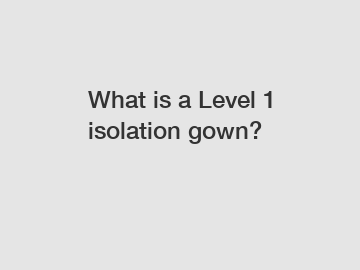What is a Level 1 isolation gown?
What is a Level 1 isolation gown?
Isolation gowns are an essential component in healthcare settings, designed to protect both patients and healthcare workers from the transmission of infectious diseases. They form a barrier between the wearer and potential contaminants, preventing the spread of harmful microbes. Level 1 isolation gowns are a specific category of gowns with specific characteristics and uses. In this article, we will explore the features and purposes of Level 1 isolation gowns in detail.
1. Definition and Purpose of Level 1 Isolation Gowns:

Level 1 isolation gowns, also referred to as minimal-risk gowns, are personal protective equipment (PPE) garments that provide basic barrier protection. They are typically used in areas or situations where there is a low risk of fluid and microbe exposure. Level 1 gowns are commonly utilized in non-surgical healthcare environments, such as clinics and urgent care centers, where there is minimal risk of encountering blood, bodily fluids, or harmful pathogens.
2. Material and Design of Level 1 Isolation Gowns:
Level 1 isolation gowns are often made from lightweight, non-woven fabrics, such as polypropylene or polyethylene. These materials offer adequate breathability while still providing a protective barrier. The gowns typically feature an open-back design with ties or closures, ensuring easy donning and doffing. They are available in various sizes to accommodate different body types.
3. Performance Standards for Level 1 Isolation Gowns:
Different organizations, such as the American Society for Testing and Materials (ASTM) and the Association for the Advancement of Medical Instrumentation (AAMI), have established performance standards to ensure the quality and effectiveness of isolation gowns. While Level 1 isolation gowns do not undergo as rigorous testing as higher-level gowns, they still need to meet certain criteria. For example, ASTM F2407-06 outlines the requirements for minimal-risk gowns, including resistance to fluid penetration and tensile strength.
4. Limitations of Level 1 Isolation Gowns:
It is important to note that Level 1 isolation gowns have their limitations. Due to their minimal barrier properties, they may not be suitable in situations where there is a higher risk of exposure to bloodborne pathogens or infectious diseases. Level 1 gowns are not recommended for surgeries or procedures involving significant fluid contact. In such cases, higher-level gowns, such as Level 2 or Level 3, which provide increased protection, are more appropriate.
5. Proper Usage and Disposal of Level 1 Isolation Gowns:
To ensure maximum effectiveness, it is crucial to use and dispose of Level 1 isolation gowns correctly. Healthcare workers should follow proper donning and doffing protocols, including washing hands before and after wearing the gown. The gowns should be worn in conjunction with other PPE, such as gloves, masks, and goggles, as necessary. After use, the gowns should be promptly discarded in designated receptacles for biohazardous waste.
In conclusion, Level 1 isolation gowns play a vital role in protecting healthcare workers and patients from the transmission of infectious diseases. While they provide basic barrier protection in non-surgical healthcare settings with minimal risk of exposure to bodily fluids and harmful pathogens, they have their limitations. It is crucial to choose the appropriate level of gown based on the specific situation to ensure the safety of everyone involved. Healthcare professionals must adhere to proper usage and disposal guidelines to maintain a secure and healthy environment.
For more information, please visit disposable medical gowns for america, disposable medical gowns for america, disposable medical gowns for america.
198
0
0


Comments
All Comments (0)